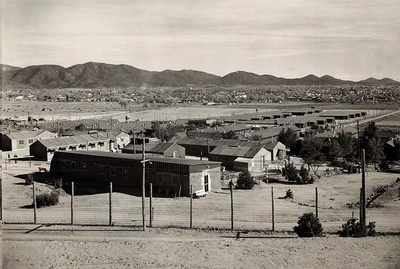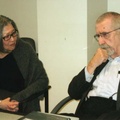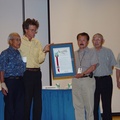A recent film on Santa Fe, Prisoners and Patriots: The Untold Story of Japanese Internment in Santa Fe, according to the film’s writer/director/producer Neil H. Simon, is the first film to tell the story of the WWII era internment camp run by the Department of Justice in Santa Fe, New Mexico.
The film (which was shown at Day of Remembrance events in Northern California and scheduled at JANM in April) assembles a rich collage of material related to Santa Fe’s history as a Department of Justice (DOJ) internment camp where so-called “enemy aliens” of Japanese descent were interned during World War II. However, the film suffers several significant flaws.
One of those flaws is that Prisoners and Patriots is incoherent and disorganized. Watching the 90-minute film is a chore, evidenced by the number of heads nodding off in the Northern California showing.
What made Santa Fe different from the WRA concentration camps, and what was the role of the Geneva Conventions in ensuring the humane treatment of internees in Santa Fe? It was never made clear that “enemy aliens” received greater protection than the prisoners in the WRA concentration camps because the Geneva Conventions governed internment at Santa Fe DOJ camp. Nor was it explained that the WRA camps were unprotected by the Geneva Conventions and that the U.S. Constitution did not protect the rights of incarcerated Japanese Americans. Without that understanding, the audience was left puzzled by descriptions of “good” treatment and the pleasures of recreational and cultural activities by the men interned at Santa Fe.
Santa Fe’s historical narrative is confused, conflating two very different stories, that of the Issei and that of the Tule Lake dissidents. The Issei were innocent of any crime but arrested in the days and weeks after Pearl Harbor, and imprisoned without due process because of their prominence within the Nikkei community. The later group interned at Santa Fe were dissident American citizens, Nisei and Kibei imprisoned at Tule Lake, whose crime was being critical of the country that removed and imprisoned them in concentration camps. Viewed as “troublemakers” by their keepers, these American citizens were manipulated into giving up their citizenship, enabling the government to legally deport them to Japan as dangerous “enemy aliens.”
The film uncritically echoes the racist biases of the war years, demonizing Santa Fe internees as “low as you could go” and “the worst of the worst.” Rather than explaining the absence of due process and the assumption of guilt of the innocent, the narrator instead characterizes Santa Fe as a place reserved for so-called “dangerous enemy aliens” and “the most pro-Japan men in the Western hemisphere.”
Adding to the confusion, several times the film incorrectly asserts that the no-nos—those who refused to give unqualified “yes” answers on the 1943 loyalty questions—were interned at Santa Fe. The no-nos were segregated at Tule Lake segregation center. Several thousand of the young male dissident leaders who renounced their U.S. citizenship, many of them teenagers, were segregated from Tule Lake and interned as “enemy aliens” at Santa Fe and Ft. Lincoln in Bismarck, ND.
In concluding the film, the incarceration in concentration camps and internment at the Santa Fe Department of Justice camp are presented in positive terms, as “a huge adventure.” The filmmaker offers this perception in a New Mexico publication, explaining his Nisei interviewee’s response: “He looked forward to the internment experience, because it was something new.”
The filmmaker uses footage of a subject who says, “I like the idea that Japanese Americans are spread all over the country. That’s a good outcome.” Such material is presented without explanation or context, with the filmmaker apparently unaware of the psychological trauma and cultural background that would cause a Nikkei survivor to describe the government-created tsunami that destroyed Nikkei communities in such a benign way.
Oblivious to the psychological coping strategies commonly adopted by Nikkei survivors, especially dissidents who have been marginalized for their wartime protest, the filmmaker asks the question, “Are you bitter?” expecting a tirade about the government’s abusive treatment. “I went into this project thinking every interview would be the same—denigrating the U.S. government and parallels to 9/11,” Mr. Simon stated. “And to a man, it was the opposite.”
Prisoners and Patriots tells some facts of the Santa Fe DOJ internment camp and may be the first film on the topic, but it will take another filmmaker to tell Santa Fe’s story with greater understanding and depth.
*Editor’s note: Discover Nikkei is an archive of stories representing different communities, voices, and perspectives. This review presents the opinions of the author and does not necessarily represent the views of the Japanese American National Museum.
If you are in the Los Angeles area, we encourage you to come to the Japanese American National Museum on April 14, 2012 for an opportunity to see Prisoners and Patriots for yourself and participate in the Q&A with the filmmaker.
© 2012 Barbara Takei






